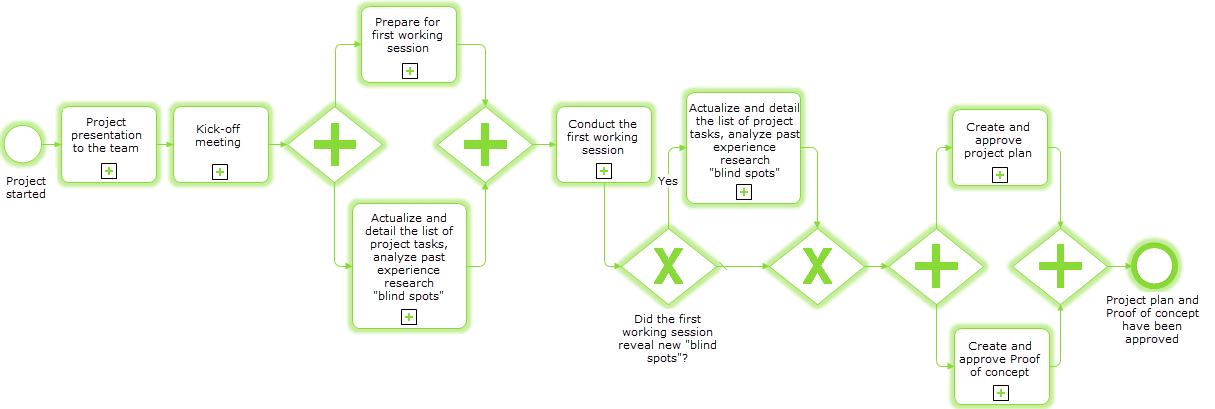Every project starts with an internal presentation by the Vendor and kick-off meeting with the Client that initiates the project. The Elaboration phase also includes resolving of all organizational questions, risk management and communication planning, defining implementation, testing and training strategies. Finally, this phase involves documenting user requirements, software and system architecture and establishing development and test environments.
Note
Use the following link to download the template for project's Project charter.
In an external implementation, the project team that works on this stage includes the Client, the Vendor’s project manager and account manager (Fig. 14). In case of an independent implementation, CRM coordinator performs the coordination of interactions with the Client (Fig. 15).
Fig. 14 Project team structure and responsibilities on the Project charter development stage (external implementation)

Fig. 15 Project team structure and responsibilities on the Project charter development stage (independent implementation)

Organizational planning and issue resolution are done in parallel, up until the Project charter is approved (Fig. 16).
Fig. 16 Project charter planning and developing diagram

Project presentation to the team
First, conduct an internal presentation for the project team, covering the following topics:
•Project goals, client’s expectations, your expectations
•Characteristics of the implemented product
•Business tasks that must be solved
•Bottlenecks in the Client’s current processes
•Agreements reached with the Client
•Client’s key contacts who are decision makers and how to work with them
•Business cases and other materials received from the Client
•Technical specifics, such as deployment option (On-site or Cloud), DBMS, etc.
Kick-off meeting with the Client
After the internal presentation is complete, conduct a kick-off meeting with the Client. At the kick-off meeting, introduce the Vendor and Client teams, present general product functions to the Client. Discuss any issues that require clarification, agreement or otherwise must be communicated to the Client. Present the Client’s project team structure to the Client, so that they could determine and assign employees to all the assigned roles. Deploy product demo to the Client.
Preparing the first working session
Based on the kick-off meeting results, prepare and send an inquiry for the whole bundle of the project documentation to the Client, review the received documents, prepare business cases and approve them with the Client. Compile the initial version of the project plan and Project charter, make revisions to the project methodology presentation. Adjust the training and working session plans taking the project’s business cases and goals into account.
Actualizing and detailing the list of project tasks, past experience analysis, working on the “blind spots”
At this stage:
1.Analyze past project experience. Reviewing past implementations usually helps decrease the number of project tasks due to initially using solutions that have proven to work in the past. Make the most use of your knowledge base, interview team members from the past projects.
2.Conduct decomposition of the high-level list of project tasks that you developed on the Initiation phase.
3.Research any tasks that may contain hidden additional workload (“blind spots”). Unforeseen tasks significantly increase the project workload. Compile a list of the identified “blind spots”.
As a result, compile the detailed list of project tasks.
Conducting the first working session
After the detailed list of project tasks has been compiled, the team begins the first working session. During the first session:
1.Conduct an initial meeting with the Client and make a presentation of the project methodology. As part of the presentation, inform the Client about project phases and their results, introduce the project team structure and roles of each team member. This presentation is very important to the Client, as it provides understanding of the internal processes and ensures the transparency of further activities.
2.Conduct training to the Client’s project team. The training includes introduction to BPMN, Creatio base function training as well as detailed demonstration of the Project charter document structure.
3.Conduct meetings with the key users, collect their requirements for working with the system, research business cases and system architecture, discuss all open questions.
Note
When working with the Client’s employees and experts, always note how many work hours are allocated to working on your project. If the expert cannot allocate enough time to project-relates interviews and other activities, escalate the issue to the next project team level on the Client’s side.
Depending on the session results, additional actualization and detailing of the project task list or additional research of “blind spots” may be needed.
Creating and approving project plan
Based on the initial working sessions, the project manager prepares the Delivery plan draft and holds a team meeting for detailing the project deliveries. Develop the project plan draft, which will be available to the users. Unlike the detailed list of tasks, the plan focuses on the task sequence, deadline and complexity, as well as lists owners of each task.
Conduct presentation of the plan for the Client, collect feedback and make revisions to the plan. After approval, the final version of the plan is handed to the Client’s workgroup and is attached to the project on a resource that is accessible by all project participants.
Creating and approving the Project charter
Make the following amendments to the Project charter template:
•Add project team roster
•Describe the functions that will be implemented
•Add Client’s project team roster
•Research possible limitations
•Publish the documents on a resource, that is accessible by all members of the project team.
Conduct presentation of the document for the Client, collect feedback and make revisions to the Project charter.
Note
The two iterations rule is applied to the Project charter approval process.
See also






